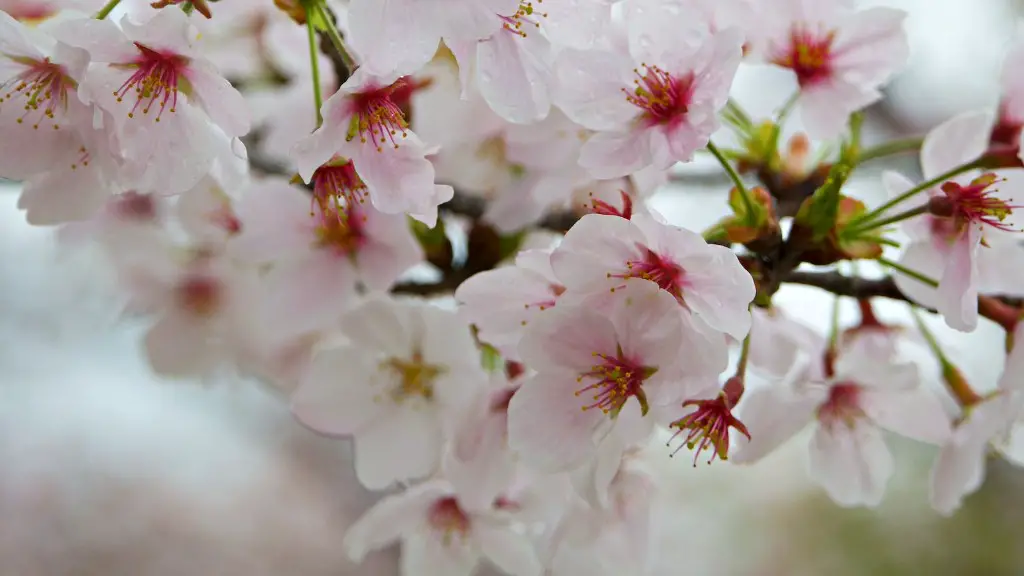Creating an Ideal Growing Environment
Weeping cherry trees, or Prunus subhirtella, love to live in warm climates. Before planting, it’s best to double check the tree’s needs as some varieties may need slightly more acidic or alkaline soils than others. An ideal growing environment should include full sun, well-drained soil and protection from wind. This will help with the growth of the cherry tree. Once planted, the tree should be misted lightly with water every three to four days.
When training weeping cherry trees, be sure to prune the branches and stems to encourage the trees to spread out and to create an optimal shape. Pruning must be done properly, so it’s best to speak to an expert in the field before beginning. However, it’s essential to prune during the winter, when trees are dormant and at their weakest.
At this time, it’s best to assess the overall shape of the tree and trim dense branches which overlapping others, or ones that are inward facing, as these can lead to the tree failing to flower to its potential.Additionally, removing any dead, diseased or broken foliage can ensure that the tree is growing in the healthiest environment possible.
Soil Amendments and Fertilizers
Fertilizers can be added to the soil around the tree to help it thrive. This can be done before planting the tree to kick-start the nutrients supply and during the growing season for maintenance and growth. Soil amendments such as compost and manure, can be used to add organics and further fertilize the soil. Additionally, mulches can be laid around the base of the trunk to help retain moisture and control weeds.
If planting in spring or summer, try to remember to water carefully – too much and the roots will be damaged; too little, and the tree may not flower to its potential. If planted too dry, the roots may struggle to establish and growth will be stunted. Regular watering during the drier months can help the tree adapt to its new environment.
Protecting the Trunk and Branches
During the first year of growth, the trees should be supported so that the trunk remains vertical and that the branches spread as much as possible. This can be done using bamboo canes or stakes. Pruning back the branches and stems to a manageable level is also recommended during the first year to help with shape and growth without damaging the foliage and bark.
Alternatively, shelters such as sheets and fleece can be used to protect the trunk from direct sunlight and to keep the warmth in during cooler months. Special guard cells are available in garden centres and can prevent animals from potentially damaging the trunk and lower branches.
Pests, Diseases and Prevention
The weeping cherry tree is prone to disease, pests and fungal issues such as leaf spot and canker, soil nematodes, aphids and borers. To prevent this, trees should be given a close inspection throughout the year, with particular attention being paid to the bark and leaves.
Fungal issues can often be treated with fungicides and pesticides are available to treat any potential pests or diseases. Organic sprays and homemade remedies – such as garlic and chilli or nettle tea – can also be used, however, it’s important to be aware of the recommended dosages as too much may do more harm than good.
Pruning Techniques
Pruning cherry trees should begin when the tree is dormant during winter and should take place every few years. When pruning, it’s important to remove any branches which are crossing or too thick. Cut these at the base to ensure that energy is not taken away from other parts of the tree.
Additionally, when pruning, be sure to use sharp, clean eradication tools and disinfect in between cuts to prevent the spread of any diseases. Once all the cutting is complete, re-mulch the base of the tree with fresh wood chips to ensure the roots remain healthy and omit any potential pests or weeds.
Choosing the Best Rootstock
The type of rootstock used when planting the tree is also important. Weeping cherry trees are often grafted onto hardy rootstocks and in some cases, a rootstock which is adapted to the specific soil or climate can be used. For example, if the soil type is very alkaline, a rootstock that is adapted to this type of soil can be used.
Speak to an expert in the field to get more advice on any specific requirements you may have and any other planting/maintenance options available.
Nourishing with Nutrients and Minerals
Weeping cherry trees need plenty of nutrients during the growing season to produce lush, healthy foliage and vibrant flowers. This can be done by using a balanced fertilizer – such as a 10-10-10 – once a month after the first winter frost. It’s also important to check your soil pH levels as this will inform you of the best fertilizer to use and ensure that the tree is getting the correct nutrients.
Applying mineral supplements such as magnesium sulphate or chelated iron to the soil can also give the cherry tree a boost. Magnesium is an essential element for a blossoming cherry tree and will help encourage the development of the fruit, foliage and colour. Iron helps to improve the overall colour of the foliage and gives a vibrant, green hue.
Wrapping it Up
Weeping cherry trees need to be given the correct care and attention to ensure they are kept healthy and strong throughout the year. An ideal growing environment should be provided from the outset, and soil amendments, fertilizers and minerals should be applied regularly. It’s important to keep an eye out for any pests, disease or fungal issues and prune back branches once winter has passed. Above all, it’s essential to provide enough protection and nourishment to keep these beautiful trees alive and blooming.


